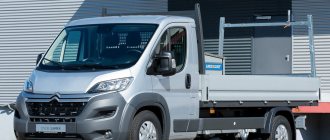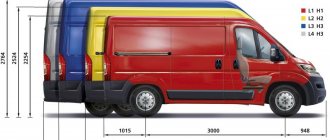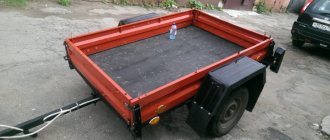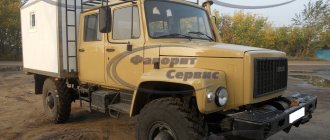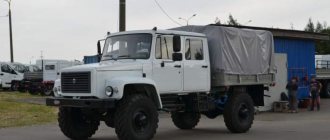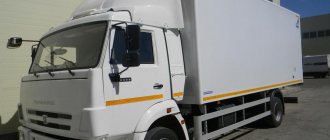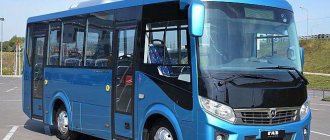When choosing a commercial vehicle, many are guided by several criteria. First of all, it is price and reliability. In fact, these are the main factors inherent in such machines. After all, the cheaper the car costs and the less often it breaks down, the faster it will pay for itself and begin to generate net profit. Today there are a lot of offers on the market. If we consider the segment of small-tonnage foreign-made cars, Mercedes Sprinter, Volkswagen Transporter, Crater and Ford Transit immediately come to mind. But there is another car with equally good characteristics. This is a Citroen Jumper. Photos, features and technical characteristics of the car are presented in our article.
Description
The Citroen Jumper is a French-made light-duty commercial van. The model was developed by the Peugeot-Citroen concern, and its analogue is also produced under the name Peugeot Boxer. Citroen Jumper is a fairly popular truck in Europe.
The car is also in demand in Russia. Models for the domestic market are assembled in the Kaliningrad region. The car became widespread in 2010. The car is characterized by a reliable engine, comfortable interior and relatively low cost.
Let's sum it up
So, we found out what characteristics and features the Citroen Jumper has. The positive aspects of this car include:
- Reliable and economical engine.
- Acceptable traction and torque.
- Comfortable salon.
- Good handling.
- Good cargo capacity.
But there are also disadvantages:
- Weak resistance of the body to corrosion (applies to first generation cars).
- Expensive service.
- Low maintainability. Most repairs and replacement of parts should be carried out at a service station.
But even with such shortcomings, it cannot be said that the Citroen Jumper is a bad car. This is an excellent analogue of the Russian GAZelle, which is second only in the cost of maintenance. Otherwise, this car has a number of positive qualities and is quite suitable for commercial transportation.
Body volume, load capacity
These figures depend entirely on the modification of the Citroen Jumper. The curb weight of the car ranges from 1.86 to 2 tons. Load capacity varies from 1 to 1.9 tons. The body can accommodate from 8 to 17 cubic meters of cargo. There are swing gates at the back. They open to an angle of 96 or 180 degrees. As an option, another mechanism can be installed here, allowing the doors to open up to 270 degrees. Optionally, a right sliding door is also installed on the Citroen Jumper van. On the left it is installed standard and is on all vans.
Salon
Citroen Jumper has a comfortable and modern interior. The cabin is designed for three people, including two passengers.
The latter are located on a double chair. The driver's seat can be adjusted in several directions, but all adjustments are only mechanical. The seat has firm padding and good lateral support, which allows you not to get tired during long periods of driving. There is also a folding armrest for the driver. The seating position is high, visibility is excellent. The steering wheel is four-spoke, with a small set of buttons. The instrument panel is a pointer type, without digital indicators. The gearshift lever, like all modern “Europeans”, is located on the front panel.
As reviews note, the Citroen Jumper has a spacious cabin. People of different heights and builds can fit comfortably here. Among the shortcomings, it is worth noting hard plastic in the cabin and not very good sound insulation.
Citroen Jumper: technical specifications
On the Russian market, the Citroen Jumper is equipped with only one single engine. It is a four-cylinder HDI turbocharged diesel engine with a 16-valve cylinder head and Common Rail injection. Engine displacement is 2.2 liters. This unit develops a power of 130 horsepower. Torque – 320 Nm at two thousand revolutions. The engine is paired with a six-speed manual transmission. Reviews note that sixth gear is what you need for trips outside the city. The maximum speed of the car is 165 kilometers per hour. The fuel consumption of the Citroen Jumper in the city is 10.8 liters. On the highway the car consumes 8.4 liters. However, as reviews note, the fuel efficiency characteristics of the Citroen Jumper may vary. This is affected not only by the height of the roof (booth), but also by the speed. The most economical mode is at a speed of 90 kilometers per hour. Reviews also note that the engine on the Citroen Jumper is very torquey and responsive. Even a loaded car can easily climb the mountain. He overtakes just as easily and confidently.
Model history
The Citroen Jumper minibus became another chapter in the history of the PSA concern. The first generation appeared back in 1994. Then everyone only compared it with the Peugeot Boxer (1994) and Fiat Ducato (1981) cars. The reason for such discussions was their identical appearance. Once you close the emblem, it’s already difficult to determine which of them is which. Everything was explained by their common production at the facilities of the Sevel enterprise, which was created in cooperation between the PSA Group and FIAT.
First generation Citroen Jumper and Peugeot Boxer vans
But this turned out to be just a shell, despite the fact that some parts were interchangeable. None of the power unit modifications could be installed on another model.
In fact, the Jumper became the successor to the older Citroen C25 model. It was presented on the occasion of the opening of the Geneva Commercial Vehicles Show. The cargo-passenger Citroen Jumper is a successful product of cooperation between three companies represented by Citroen, Peugeot and Fiat.
First generation 1994-2006 years of production
Citroen Jumper II can be distinguished by its characteristically changed front part.
The first generation was produced for the European market (restyled models of 2002 were sold in Russia) and was represented by several modifications:
- vans 2002 2.0 MT L1H1, L2H2;
- vans 2002 2.2 HDi MT L1H1, MT L2H2;
- vans 2002 2.8 HDi MT L1H1, L2H2;
- minivans 2002 2.0 MT COMBI CLUB;
- minivans 2002 2.2 HDi MT COMBI CLUB;
- minivans 1994 1.9D MT 27C/27CH, 27CH;
- minivans 1994 1.9TD MT 27C/27CH, 27CH;
- minivans 1994 2.0i MT 27C/27CH, 27CH;
- minivans 1994 2.5TD MT 27C/27CH, 27CH;
- minivans 1994 2.5D MT 27C/27CH, 27 CH;
- vans 1994 1.9D MT 27C/31C, 27CH/31CH;
- vans 1994 1.9TD MT 27C/31C, 27CH/31CH;
- vans 1994 2.0i MT 27C/31C, 27CH/31CH, 31M, 31MH/35MH, 31LH/35LH;
- vans 1994 2.5TD MT 27C/31C, 27CH/31CH, 31M, 31MH/35MH, 31LH/35LH;
- vans 1994 2.5D MT 27C/31C, 27CH/31CH, 31M, 31MH/35MH, 31LH/35LH.
Minibus Citroen Jumper II in the richest configuration with a full range of options.
The fuel tank volume in first generation cars is 80-120 liters.
Second generation since 2006 release
The line received restyled models in 2014:
- flatbed truck with manual transmission, front-wheel drive and diesel engines of 130 and 150 hp;
- minivan with manual transmission, front-wheel drive and diesel engines of 130 and 150 hp;
- all-metal van with manual transmission, front-wheel drive and 130 hp diesel engine.
All-metal van Citroen Jumper III 330 L2H2
There is a huge variety among the second generation trim levels.
This:
- trucks 2014 2.2 HDi MT L3, L4, L3 side curtain, L3 S side curtain, L4 side curtain;
- minivans 2014 2.2 HDi MT L1H1 Tour Standart, L2H2 Tour Standart, L4H2 minibus, L4H2 tourist;
- vans 2014 2.2 HDi MT L1H1 (2.5, 2.8, 4t), L2H2 (2.5, 2.8, 2.9, 4t), L3H2DI (2.5, 2.8t), L3H2 (3.5, 4t), L3H3 3.5t, L4H2 3.5 t, L4H2MC11 4t, L4H3 3.5t, L4H3MC11 4t, L1H1 Tour Transformer, L2H2 Tour Transformer, L2H2 Profi Transformer, L3H2 Profi Transformer, L4H2 Profi Transformer;
- vans 2006 2.2 HDi MT L1H1, L2H1, L2H2, L3H3, L4H2, L4H3;
- minivans 2006 2.2 HDi MT L1H1 Tour Standard, L2H2 Tour Standard, L4H2 tourist.
Minibus Citroen Jumper III Minibus 330 L2H2
The fuel tank volume in second generation cars is 90-120 liters.
Suspension
This car is built on a front-wheel drive “trolley”, where the supporting structure is the body itself. The latter is made of high-strength steel grades. The engine is located transversely relative to the body. This design is more reminiscent of passenger cars, so it is not surprising that the front features MacPherson struts and A-arms with a stabilizer bar. There is a beam at the back. Depending on the modification, there may be one or two springs. The latter scheme is practiced on extended versions of the Citroen Jumper.
Appearance
The design of the first generation of this truck is unremarkable. So, the car has simple, angular headlights, a regular black bumper and a short, flat hood.
By the way, the engine partially extends into the cabin, which somewhat complicates repairs and maintenance. Among the features, it is worth noting that the Citroen Jumper van was produced with a body of different lengths and heights. Thus, there were both short-wheelbase and elongated modifications. The most voluminous among them is “Maxi”.
The car was produced in this form until 2006. after that the second generation of commercial vans came out. The reader can see what the updated Citroen Jumper looks like in the photo below.
Among the significant differences, it is worth noting the headlights. They began to be located almost at the front window. The bumper has also changed. On most versions it is still black, but it now has holes for fog lights. The hood is still compact - it is only needed to add technical fluids.
The third generation of Citroen Jumper commercial vans appeared in 2014. The car is built on the same platform, but the appearance has changed again. Thus, the headlights became narrower and LED running lights appeared. The radiator grille has become wider, and the bumper has become embossed. Depending on the modification, fog lights or plugs for them may be located below.
Ride quality
How does the Citroen Jumper behave on the road? Surprisingly, this van doesn't handle like a truck at all. Behind the wheel, the driver feels like driving a passenger car. The Citroen Jumper corners just as easily and handles predictably. The car is maneuverable and agile.
As for the smoothness of the ride, it is not the best here - that’s what the reviews say. Still, the rear beam and leaf spring suspension make themselves felt. When the car is empty, it's a little rough on the road. But as soon as you load the “tail”, the car immediately changes its behavior. This is typical for all cars of this class. Outside the city the car handles well. It is stable at high speeds. But if you drive more than 100 kilometers per hour, you should expect excessive fuel consumption.
Chassis of the Citroen Jumper
As we said earlier, the car is built on a front-wheel drive platform with a transverse power unit. At the front there is an independent double-wishbone suspension with MacPherson struts. At the rear, everything is arranged much simpler: a dependent beam and leaf springs. The shortened versions of the “Jumpers” have one leaf of springs installed. On medium-base sheets with springs. As for the extended versions, they have reinforced suspension. So, the beam is equipped with two springs on each side.
The brake system is hydraulic, with a vacuum booster. Brakes are discs at the front and drums at the rear. As for the third generation, here disc elements are installed on both axles. The car is standardly equipped with 15 or 16 inch wheels. The latter come on versions with a maximum weight of 4 tons. Note that the spare wheel is located under the bottom, in the rear of the body. Among the problems is an unreliable winch that fails due to the gearbox.
Price
At the moment, the cost of a Citroen Jumper car starts from 1 million 640 thousand rubles. The package includes:
- Audio preparation.
- Hydraulic power steering.
- One airbag.
- On-board computer.
- Electronic immobilizer.
More expensive versions have electric windows, air conditioning, and a full multimedia system with Bluetooth support.

